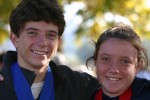Joseph D. Grant County Park (South)
Date: (Sun.) Apr. 17, 2005
Location: San Jose, CA
Event Directors: - 408.878.5073, - 510.886.7360
Course Setters: Derek Maclean, Dean French
Type: B; All seven standard courses, plus Long Orange
Course Setters' Notes
By Derek Maclean and Dean French
This is a beautiful time of year in the park. Everything is lush and green, and wildflowers cover every meadow. We hope that you enjoy your courses as much as we have enjoyed setting them.
Summary of Courses
Course Length Climb Technical Physical
White 2.8 km 80 m Beginner Stroller-friendly Yellow 3.0 km 160 m Advanced Beginner A robust hike Orange 3.7 km 150 m Intermediate Tougher Long Orange 5.6 km 180 m Intermediate Tougher and longer Brown 4.6 km 250 m Advanced Challenging Green 5.2 km 280 m Advanced Very challenging Red 6.1 km 340 m Advanced Even more challenging Blue 7.4 km 420 m Advanced Long and very tough
White, Yellow, and Long Orange starts are adjacent to registration. Orange, Brown, Green, Red, and Blue start at Buck Pond, a 2 km walk from Registration with 30 m climb -- allow 25 minutes. Make sure to allow enough time to complete your course by the closing time of 2:00 pm.
The White course is suitable for beginners and is reasonably stroller-friendly. It takes paved roads through the campsite then loops back to the finish on dirt trails for a total of 2.8 km. All the control markers are readily visible from the trails.
The Yellow course ventures a bit further afield, following a dirt path circuit with substantially more hills than the White course. Several controls are a short distance off the trail, and some bush-whacking will be needed. Some off-trail shortcuts may also be possible. The White and Yellow courses visit different areas, so if White was not enough for you, and time allows, you may wish to also try the Yellow course.
The Orange course is almost all off-trail, mainly through open meadows, and never very far from a major trail, although the navigation is a significant step-up from Yellow.
Long Orange is similar to Orange, except that it starts adjacent to registration. You will navigate through several additional controls before joining the Orange course near the advanced course start. Perfect for those with energy to burn, but less navigational experience.
Brown, Green, Red, and Blue are advanced courses offering significant physical and technical challenge. These courses visit some very rugged areas, and are only for experienced orienteers. Finish times are expected to be on the longer end of typical Bay Area courses. Navigational mistakes in the steep terrain may result in significant extra climb or distance in addition to the stated figures. This is probably not a day to run up a course.
Precautions
There is a large amount of poison oak in the park. It may be encountered on any course except White, although it is most noticeable on the Red and Blue courses. Courses have been planned to avoid the worst areas, but this is prime growing season. Take appropriate precautions, including wearing long sleeves and pants, and avoiding the distinctive plants with shiny green leaves in sets of three. Wash off skin with soap and cool water as soon as possible after returning; bag and wash clothes before re-wearing. Use a specialized product such as Technu as a precaution or if you're known to be sensitive.
Water has been placed at at least one control on each of the advanced courses. If the weather is warm, please take precaution and drink plenty of fluids before competing. Be courteous to fellow competitors -- do not waste water at the water stops. The Yellow and White courses will go past several taps in the campsite area that can be used for drinking.
Map Comments
The damp weather has caused the area to be generally wetter than mapped. You may encounter unmapped small streams and marshy ground. Cleated shoes are strongly recommended, especially for the Green, Red, and Blue courses.
Years of erosion since the base map was completed mean that many valleys are significantly deeper and more steep-sided than mapped. Stream beds are often very rugged, and are generally not the best route choice, particularly if many crags and other rock features are shown. Some gullies may necessitate minor detours to find a suitable crossing point.
All advanced courses cross several fences. In general you can pass under these, especially where animal tracks pass through the fence. Please take care to avoid damaging the fences, and report any such damage to event officials.
The distinction between white (runnable) forest and groups of lone trees is sometimes clearer on the map than on the ground. Some "lone trees" are now large, dead rootstocks.
Some rough open areas have many unmapped thickets of head-high brush. These do not significantly impede passage, but do reduce visibility in those areas.
Many unmapped animal tracks are present that may be as evident as some mapped indistinct trails.
Animals
There are many cows in the park. These have proved to be totally tame in all encounters so far, but try to avoid getting between a cow and its calf.
The park is also infested with huge numbers of feral pigs that have torn up large areas, especially around oak trees. The pigs mostly snooze in the bushes in the daytime, and tend to avoid people, although they can startle you when they burst out of the brush in your vicinity. Again, keep an eye out for piglets, and don't get between them and their mothers.
Mountain lions are also present in the park. If you see one, make yourself look as large as possible. Stand up and wave a stick, but do not bend down to pick one up. Keep small children close at all times. Do not turn and run, or the cougar may think you are prey. Fight back if attacked.

